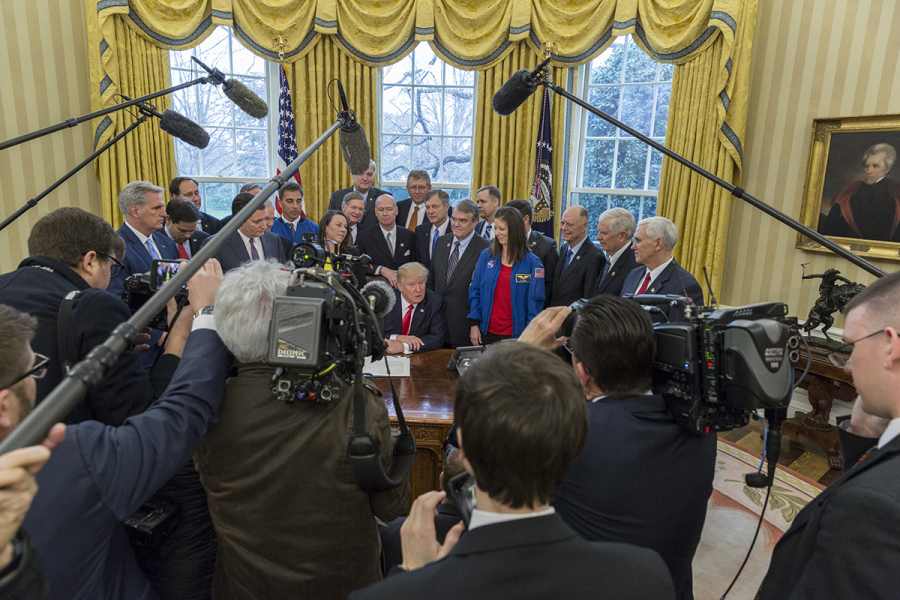Column: Media diversity left behind in Trump era
Photo Courtesy Wikimedia Commons
American news media does not reflect the diversity of the nation, and it struggles to reverse the historical erasure of a wide range of voices.
February 20, 2019
In adapting to this bloodthirsty world of constant breaking news with simultaneous accusations of “fake” news, investigative journalism skyrocketed and the press became more important than ever before. That does not come without a price.
The price of an increasingly fast-paced news cycle is that insensitivity regularly makes it past editors, whether due to a rush to publish or a lack of journalists with diverse perspectives who can evaluate stories for such errors.
Furthermore, young journalists in the making, like myself, are not taught how to address insensitivity constructively or incorporate a method into our writing process to catch these errors.
In smaller publications, insensitivity is as glaring as this (since-deleted) headline The Mercury News shared in 2016 following an American win at the Olympics: “Michael Phelps shares historic night with African-American.” You may know this African-American as Simone Manuel.
Additionally, in a time when condemning racial rhetoric should be just as important as reporting it, the media has stepped back rather than confront it head-on. For example, sometimes it’s what isn’t said that is just as insensitive as what is.
When Steve King received backlash for his comments defending white supremacy in this New York Times article, NPR simply called his string of remarks over 16 years in Congress “racially charged.” In fact, “racist” appeared only twice in the article — both times in different quotes. In the wake of the blackface scandal in Virginia, the New York Times equated “dark makeup” to the blackface Virginia Attorney General Mark Herring also admitted to wearing.
Distasteful, controversial, culturally insensitive — these are words that dance around calling out racism for what it is, words that shield white journalists from the power racism carries.
The fact of the matter is that American news media does not reflect the diversity of the nation, and it struggles to reverse the historical erasure of a wide range of voices.
Newsrooms are good at writing stories about the lack of diversity within their own newsrooms or the need for it across the country. Yet, they are just as good at maintaining that lack of diversity and doing little to address the need for it. Even efforts to address this fault reflect the struggle for diversity in newsrooms across the nation.
The best example was pointed out by Liz Spayd, a public editor at the New York Times. In “Preaching the Gospel of Diversity, but Not Following It,” she criticized the hypocrisy of her employer for criticizing the lack of diversity in the newly-elected president’s cabinet when the more than 20 reporters tasked with covering his presidential campaign had even less diversity, including only two black reporters and no Latino or Asian reporters.
Fast forward more than two years to when CBS announced the reporters chosen to cover the 2020 presidential election. Of the eight reporters, not one was black and more than half were male — garnering a backlash on Twitter CBS seemed shocked to receive. Will we ever learn?
The American Society of News Editors has a yearly Newsroom Employment Diversity Survey. In 2018, the survey found the average publication staff was 59 percent male. Over the course of 17 years, newsrooms increased gender and racial diversity only a little more than 30 percent — meaning newsrooms today still consist of more than 50 percent white and male reporters.
Despite a small rise in diversity over the course of a decade, there is a quote by Cindy Hook, an American businesswoman, I find particularly fitting: “Diversity without inclusion is simply a number.”
With these facts and statistics come mistakes, inevitable when majority-white newsrooms tackle issues they cannot empathize or relate to. White and male journalists don’t know what it’s like to have what journalism professors call “skin in the game” when it comes to issues of race, gender and sexuality.
The difference is clear to journalists who understand this disparity. Earlier this month, April Ryan, a successful journalist and author, bureau chief for American Urban Radio Networks in Washington, D.C. and CNN political analyst, came to Northeastern. I rushed straight from my morning classes to hear her speak and have her sign my book. I nearly stumbled over my words as I introduced myself, praised her book and told her how her career inspired me.
She gave me specific suggestions to expand my palette of knowledge and encouraged me with advice from one journalist to another. Just before I turned and left, she said, “And always make your voice heard.”
I am discouraged by the fundamental flaws in the lack of diversity and growing insensitivity in the profession I’ve chosen to pursue, but I am a fierce believer in accountability.
Regardless of whether I’m the only Latina or black woman in the room or not, I will take Ryan’s advice to heart for all the women of color revolutionizing journalism as I strive to enter the field; for the Ida B. Wellses and Cecilia Alvears no longer with us, for the Andrea González-Ramírezes, Maria Hinojosas and Ilia Calderóns, for all the Jenna Worthams, Tanzina Vegas and Errin Haines Whacks of today.
Like them, in this high-speed world where journalism must operate to record history the second it happens, I will make my voice heard. As for the institution of the press I hold so dear, do better — the world is watching.


















